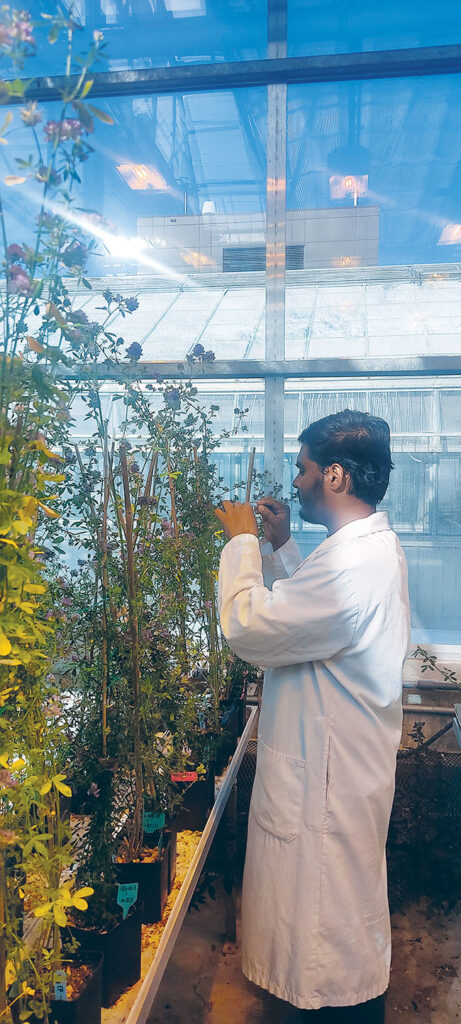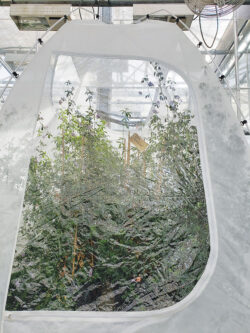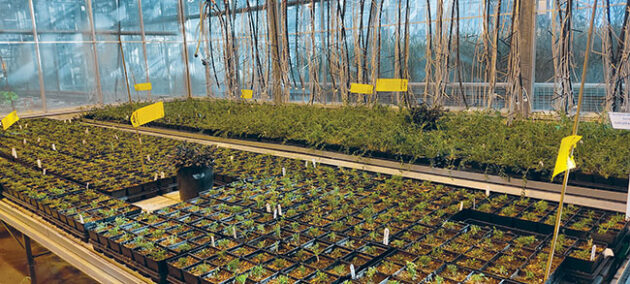
Features
Environment
Genetics/Traits
Plant Breeding
Alfalfa for a resilient future
Seeking success in climate-stressed times.
September 26, 2023 By Caroline King
 Graduate student Mukthar crosses alfalfa lines in Poudel’s breeding program.
Photo courtesy of Mohammed Musthafa Mukthar, University of Alberta and AAFC
Graduate student Mukthar crosses alfalfa lines in Poudel’s breeding program.
Photo courtesy of Mohammed Musthafa Mukthar, University of Alberta and AAFC Two research scientists from Agriculture and Agri-Food Canada (AAFC) in Lethbridge, Alta., are working to improve alfalfa’s traits for success in a climate-stressed future. They are tackling this challenge from various angles.
On one hand, their research includes studies to enhance alfalfa’s ability to withstand climate stresses such as drought. On the other hand, they are developing alfalfa lines with higher nutritive value for cattle that could also reduce methane emissions from those cattle.
Additionally, one of these researchers, Stacy Singer, is adopting a molecular approach to forage breeding. The other, Hari Poudel, is employing conventional forage breeding strategies. Together, they are collaborating to accelerate progress in alfalfa variety improvement.
Withstanding drought
One of Singer’s research goals is to boost alfalfa’s tolerance to various weather-related stresses, such as salinity and waterlogging, with a primary focus on drought tolerance.
“Alfalfa is relatively drought-tolerant compared to many other crops, but that doesn’t mean it’s perfect, nor does it mean it doesn’t suffer from sometimes significant decreases in productivity due to drought. So, there is still ample room for improvement,” she explains.
“With droughts becoming more frequent and severe, it’s imperative that we address this in all our crops, including alfalfa.”
As part of this research, Singer and her research group are investigating the molecular mechanisms involved in water deficiency tolerance. “Considerable knowledge now exists about the various pathways and mechanisms that plants employ to achieve drought tolerance and respond to drought stress. However, significant gaps still exist in our understanding of the processes and how these plants react to this kind of stress,” she notes.
“We are working on filling some of these knowledge gaps in alfalfa, striving to ascertain precisely how these plants respond, the strategies they utilize, the metabolic changes they undergo, the shifts in genes and gene expression they employ to react to drought and which of these changes might be advantageous or detrimental to the plant.
“Subsequently, we aim to use this information to breed alfalfa plants better equipped to endure future droughts. We hope this information will also prove beneficial for other breeders and crops.”
Some of her group’s recent research involves comparing drought responses in specific drought-susceptible alfalfa varieties and in drought-tolerant examples of one of alfalfa’s close wild relatives. Singer says, “It’s intriguing to examine these wild relatives, which may have evolved in environments that were exceedingly dry, salty, or slightly waterlogged. These wild plants tend to withstand these pressures better than some of the cultivars we use today.”
Their findings indicate that different examples of this wild relative may employ varying drought-response mechanisms. They have also identified several genes related to the wild relative’s greater drought tolerance, which could be pertinent to their efforts to enhance drought tolerance in alfalfa.
One of the researchers collaborating with Singer is Abdelali Hannoufa, a research scientist with AAFC in London, Ont. Singer and Hannoufa have together developed a CRISPR/Cas9-based gene editing platform for alfalfa, now applied in their drought tolerance work. For instance, they have utilized gene editing to investigate how minor variations in a key gene related to alfalfa’s drought response influence the plant’s ability to endure drought.
“Moving forward, we will use the data generated in our studies so far to aid in understanding which pathways and genes are affected,” Singer says.
“Once we identify these genes, we then need to test them to determine their functions and whether they induce some form of difference in drought response. If they do, we proceed to investigating how they elicit these effects and the changes that occur within these plants. This process involves extensive work to uncover these details.”
Further work involves testing their experimental alfalfa lines in the field. Singer says, “Currently, we have developed plants that appear more drought-tolerant than others based on greenhouse assessments. The subsequent step involves observing their performance under field conditions to see if the effects are consistent or somewhat different.”
Support for Singer’s research into alfalfa drought tolerance comes from the Beef Cattle Research Council, Alberta Milk, Alberta Beef Producers, Results Driven Agriculture Research, as well as AAFC.
A multi-agency effort
Singer collaborated on some of her drought tolerance studies with Surya Acharya, a forage breeder at AAFC-Lethbridge who recently retired. Now, Singer is working closely with Poudel, who has taken over this breeding program.

Using bumble bees to pollinate some of the EMS-treated alfalfa plants in Poudel’s program.
Photo courtesy of Mohammed Musthafa Mukthar, University of Alberta and AAFC
Alfalfa is a priority crop in Poudel’s program. The program continually seeks lines that remain productive even in the face of environmental stresses, boasting an array of drought-tolerant lines.
Poudel is a part of a new national project aimed at enhancing drought tolerance in alfalfa. The project involves the alfalfa breeding programs at the University of Saskatchewan (USask), the University of Manitoba and the AAFC Research and Development Centres at Lethbridge, Swift Current, Sask., Quebec, Que., and Kentville, N.S. USask forage breeder Bill Biligetu is leading this project.
Poudel notes that each of these six programs is contributing two distinct drought-tolerant lines to the project. All 12 lines are cultivated at each of the six locations. The research teams employ rainout shelters to ensure the lines experience drought stress.
“The goal is to screen for drought tolerance and develop different populations across diverse locations,” says Poudel.
This research could significantly advance the development of drought-tolerant alfalfa varieties suitable for varying growing regions.
High feed efficiency, lower emissions
Mitigating methane emissions from cattle could bolster consumer confidence in the environmental sustainability of the beef industry and contribute to agricultural efforts to combat climate change.
Poudel leads this project, collaborating with Singer and others. They are taking an innovative approach to the issue, one that could enhance production efficiency for cattle producers, potentially provide health benefits to cattle, and simultaneously lower methane emissions.
“Scientists have pursued various approaches to reducing greenhouse gas emissions from cattle. For instance, several feed supplements have proven effective in reducing methane emissions from ruminants consuming supplemented feed. One of these supplements is vegetable oil. However, incorporating vegetable oil supplements carries costs for producers,” Singer explains.
“Hence, we wondered if it was feasible to slightly elevate the production of vegetable oil in alfalfa shoots. A modest adjustment can yield effects. This approach could potentially reduce costs for producers, as there would be no need for feed supplementation. Also, supplementing feed while cattle are grazing can be challenging, making this method advantageous.”
Furthermore, Singer and Poudel highlight that higher levels of leaf oil, or ‘lipids,’ in alfalfa could lead to cattle consuming less while achieving the same growth and productivity, thereby enhancing cattle production efficiency.
“Lipids are calorie and energy-dense. A gram of lipid can provide nine calories, compared to about four calories from a gram of protein,” notes Poudel. “A one per cent increase in the lipid content in feed can lead to a 5.6 per cent reduction in methane production.”
According to Poudel, the lipid content in alfalfa vegetative matter typically ranges from about 1.5 to 2.5 per cent, with an average of two per cent on a dry matter basis. The researchers’ objective is to elevate the lipid content to around five per cent.

Poudel’s group is using EMS, a chemical mutagen, to produce large populations of alfalfa plants with random mutations in order to find plants with higher leaf oil levels.
Photo courtesy of Mohammed Musthafa Mukthar, University of Alberta and AAFC
Generating variation
Poudel elucidates that the genetic variability within the alfalfa gene pool for leaf lipid content is quite limited. Thus, relying solely on crosses with existing alfalfa lines to heighten lipid content would yield slow progress.
This is why Poudel and Singer are exploring two distinct approaches to developing alfalfa lines with slightly higher lipid content.
Poudel’s group is employing chemical mutagenesis. “Chemical mutagenesis is a cost-effective method for creating non-transgenic mutants,” he notes. “It employs chemical mutagens like EMS (ethyl methanesulfonate) to generate numerous random mutations. These mutations can be either beneficial or detrimental to the plant. Consequently, plant breeders must screen large populations of offspring to identify the specific beneficial mutations they seek.”
In this approach, researchers usually begin with an adapted variety that already performs well. Then, they determine the optimal mutagen dosage and timing to generate the desired mutation while retaining the plant’s favourable traits.
The project was initiated by Acharya before Poudel joined AAFC. Acharya’s team established the optimal EMS dose and timing.
Poudel’s group recently completed the initial round of EMS treatments, carried out by Mohammed Musthafa Mukthar, a University of Alberta graduate student involved in the project. The EMS-treated population displays greater variability and a higher average lipid content compared to the control group of non-treated plants.
In the ongoing second round, they are selecting 50 plants with approximately 20 per cent higher average lipid content than the base population for advancement to the next generation. These samples are being sent for lipid profiling to Gavin Chen, Canada research chair in plant lipid biotechnology at the University of Alberta.
“The plant samples contain a variety of fatty acids, encompassing distinct types such as saturated and unsaturated fats, as well as specific ones like oleic, linoleic, or linolenic acids,” says Poudel. “Dr. Chen is quantifying and classifying the lipids, for example, in terms of saturated/unsaturated, beneficial/harmful. Increasing beneficial lipids in alfalfa, if not overall, could still offer advantages for cattle health.”
Moving forward, Poudel’s group plans to conduct a transcriptomics study leading to the identification of differentially expressed genes. He notes, “If we identify a significant gene affecting lipid content, we will validate the finding using gene editing techniques, such as knocking out that gene and observing its impact on the lipid mechanism or pathway.”
Poudel’s group will continue making repeated selections on EMS mutants for each new generation, up to the fifth generation.
Alongside their work on the molecular aspects of the EMS study, Singer and her group are investigating the potential of gene editing to elevate lipid levels in alfalfa. Gene editing is a breeding tool that creates highly targeted mutations.
“We are exploring various genes that could hinder oil accumulation in alfalfa shoots. Prior research in other plants has suggested that specific genes might inhibit oil accumulation. We are investigating the roles of these genes in alfalfa and whether we can leverage this information to enhance oil accumulation in alfalfa shoots,” Singer explains.
“We have preliminary data indicating a small yet significant increase in oil in alfalfa shoots with two of these genes when we deactivate them. We are not adding anything extra to these plants; we are merely deactivating genes that negatively impact oil accumulation.”
While these initial findings are promising, this gene editing research is still in its early stages. “Going forward, we will undertake further work to validate these results and confirm that the changes are indeed consistent and significant,” says Singer.
“Subsequently, we will need to take these plants to the field to ensure they perform well. We will also need to determine whether these changes in oil accumulation in alfalfa have an impact on methane emissions when cattle consume the plant.”
While she is intrigued by the long-term potential of increasing the level of beneficial lipids, for now, Singer’s focus is solely on total lipid levels.
In addition to alfalfa, this lipid project also involves the same type of work with sainfoin. The initial phase of this research was funded by Alberta Beef Producers and Saskatchewan Cattlemen’s Association, while the ongoing phase receives funding from the Beef Cattle Research Council and Saskatchewan’s Agriculture Development Fund. Poudel also underscores the significance of support and resources from AAFC, collaborators, technicians, graduate students and summer students.